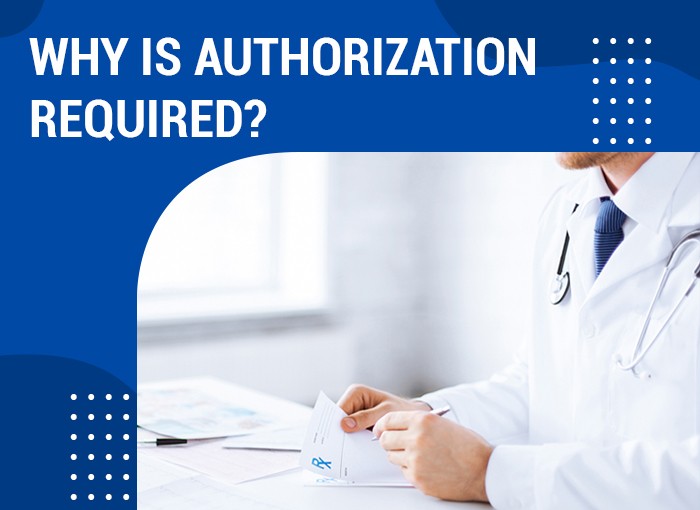WHY IS AUTHORIZATION REQUIRED?
Preauthorization, precertification or prior authorization are terms used interchangeably in the medical billing world. Some situations and procedures require authorization requests in advance from the insurer to be reimbursed fully for the services.
Verification and authorization play a vital role in managing the revenue cycle, as most of the denials happen during this process. Preauthorization is where the providers determine the coverage based on medical necessity, and benefit limits and obtain approval from the insurer for the rendered service.
For instance, if a physician is prescribing a particular drug or service and has to obtain authorization from the insurer to keep healthcare costs in check, in that case, they send an authorization request, and the insurer checks the medical necessity of the service or drug before agreeing to pay. As a result, the rationed healthcare process usually takes five to thirty days, depending upon the insurer.
Importance of Authorization
The process does not guarantee reimbursement, although if necessary and not provided can result in claim denial or non-reimbursement. Providers obtain an authorization number which is included in the claim to avoid any denials.
This process will make sure that the service is not duplicated and help the patient to recover. If your claim still gets denied stating lack of medical appropriateness, then appeal to absorb costs for procedures that were preauthorized.
- Avoiding Claim Denials: Authorization may not guarantee reimbursement, but it reduces the claims denials risk due to lack of preapproval. Hence the provider has to write the authorization number in the claims to avoid denials.
- Cost Control: Insurers use authorization to manage healthcare costs by ensuring that prescribed treatments are necessary and not redundant.
- Patient Safety: By preventing duplicate or unnecessary procedures, authorization safeguards patients against potential harm and aids in quicker recovery.
- Efficient Revenue Cycle Management (RCM): Timely authorization ensures smoother billing and payment processes, allowing providers to focus on delivering quality patient care.
If a claim is denied despite preauthorization, providers can appeal the decision, often absorbing costs for treatments that were initially approved.
Procedures that require authorization
Many insurers require authorization for a set of expensive & risky procedures before seeing a physician. Most PPO benefit plans use a pre-certification requirement from the provider for inpatient hospital admissions like inpatient rehab, acute care, etc. & coordinated healthcare like home infusion therapy, skilled nursing visits, etc.
Other procedures require authorization to review the medical necessity and help lower the cost of expensive prescriptions.
Expensive and Risky Procedures:
- CT scans
- MRIs
- PET scans
All prescription drugs
Durable Medical Equipment (DME)
Inpatient admissions to the healthcare facility
Coordinated Health Services
No authorization was obtained in any emergency department or post-stabilization care services for outpatient emergency care. The treating physician makes it medically necessary until the patient’s condition gets stabilized.
Submission Process for an authorization request
The provider can submit an authorization request both electronically and manually. Authorization forms are available offline and online for a written authorization request. Every insurer has its specifications, though the following remains unchanged.
- Patient demographic details are updated during the verification process, like insurance ID number, name, date of birth, etc.
- Referring and service provider details like Tax ID number, NPI (National Provider Identifier) number, phone, fax number, and service address
- Medical procedure/requested service along with correct CPT/HCPCS codes • Diagnosis description and corresponding ICD codes
- Specific details about service location like Tax ID number, NPI number, Address, phone, and fax number
- Length of hospitalization for inpatient care
Additionally, the provider has to submit medical notes supporting the rendered service. If an insurance company asks, you must submit supporting documents like previous treatments and elucidations on the provided service.
Authorization at the right time helps to improve RCM while you can focus on quality patient care. Early submission of the authorization request before the treatment helps obtain the authorization number on time to prevent any rejections.
Benefits of Timely Authorization
Obtaining authorization well before the treatment date offers several advantages:
- Improved Revenue Cycle: Early authorization minimizes disruptions in the billing process, ensuring timely payments.
- Enhanced Patient Care: Providers can focus more on patient care rather than administrative hurdles.
- Reduced Risk of Denials: Proactive submission reduces the likelihood of claim rejections, saving time and resources.
Challenges in the Authorization Process
Despite its importance, the authorization process is not without challenges. Common issues include:
- Delays: Long waiting for approval may delay valuable treatment-the patient suffers.
- Complex Requirements: Different insurers have varying specifications, which can lead to confusion.
- Errors in Submission: Denials can occur due to incomplete or wrong information.
- Appeals: If the claims do not get preauthorized, the time-consuming, resource-intensive task is an appeal.
Some use custom departments to handle the work and others have effectively outsourced to historical third-party providers for authorization and verification coverage.
Conclusion
Authorization is one of the strongest links connecting the advantages of planning and delivering medical services, as well as the control of costs in the modern healthcare system. Although the process may seem tedious, the challenges are far outweighed by its benefits while ensuring efficient resource utilization with quality improvement in patient outcomes. As such, adherence to insurers’ guidelines for the submission of timely and accurate requests can help healthcare providers streamline their revenue cycles, thus focusing on what matters—delivering outstanding patient care.
The greater the complexity of preauthorization, the more likely you should address it with Capline Healthcare Management. We are dedicated to managing the authorization process, thereby allowing the rest of your team to continue focusing their efforts on delivering high-quality care to its patients.



